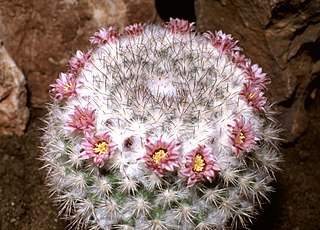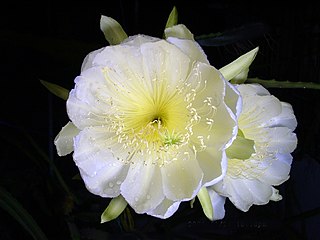
Mammillaria is one of the largest genera in the cactus family (Cactaceae), with currently 200 known species and varieties recognized. Most of the mammillaria are native to Mexico, but some come from the southwest United States, the Caribbean, Colombia, Venezuela, Guatemala and Honduras. The common name "pincushion cactus" refers to this and the closely related genus Escobaria.

Parodia is a genus of flowering plants in the family Cactaceae, native to the uplands of Argentina, Peru, Bolivia, Brazil, Colombia and Uruguay. This genus has about 50 species, many of which have been transferred from Eriocactus, Notocactus and Wigginsia. They range from small globose plants to 1 m (3 ft) tall columnar cacti. All are deeply ribbed and spiny, with single flowers at or near the crown. Some species produce offsets at the base. They are popular in cultivation, but must be grown indoors where temperatures fall below 10 °C (50 °F).

Weingartia is a genus in the family Cactaceae, with species native to Bolivia and Argentina.

Echinocactus grusonii or Kroenleinia grusonii, popularly known as the golden barrel cactus, golden ball or mother-in-law's cushion, is a species of barrel cactus which is endemic to east-central Mexico.

Selenicereus megalanthus, synonym Hylocereus megalanthus, is a cactus species in the genus Selenicereus that is native to northern South America, where it is known, along with its fruit, by the name of pitahaya. The species is grown commercially for its yellow fruit, but is also an impressive ornamental climbing vine with perhaps the largest flowers of all cacti.

Echinocereus reichenbachii is a perennial plant and shrub in the cactus family. The species is native to the Chihuahuan Desert and parts of northern Mexico and the southern United States, where they grow at elevations up to 1,500 meters (4,900 ft). This cactus earned the Royal Horticultural Society's Award of Garden Merit.

Parodia buiningii is a rare species of cactus native to South America. It is a solitary spherical or oblate cactus only a few inches in height with long, yellow spines. It bears yellow flowers, and produces hairy fruit and black seeds. It is found surrounding the towns of Santana do Livramento, Brazil and Rivera, Uruguay.

Parodia leninghausii is a species of South American cactus commonly found as a houseplant. Common names include lemon ball cactus, golden ball cactus and yellow tower cactus.

Parodia magnifica is a species of flowering plant in the family Cactaceae, native to southern Brazil. One of several species called ball cactus, it grows to 7–15 cm (3–6 in) tall by 45 cm (18 in) broad, with heavily ribbed, spherical to columnar, spiny and hairy stems, bearing pale yellow flowers in summer. Its natural habitat is cool, dry temperate grassland at elevations of up to 800 m (2,600 ft). Populations are sparse and fragmented, and it has been designated as “Endangered” by the IUCN Red List.

Parodia arnostiana is a species of cactus in the genus Parodia. The small, squat green plants produce yellow flowers, green fruit and black seeds. The species is found growing in Rio Grande do Sul, Brazil.

Sclerocactus brevihamatus is a species of cactus known by the common name shorthook fishhook cactus.

Cereus hildmannianus is a species of cactus from southern South America. Its distribution is uncertain but probably includes Brazil, Paraguay, Uruguay and Argentina.

Opuntia macrocentra, the long-spined purplish prickly pear or purple pricklypear, is a cactus found in the lower Southwestern United States and Northwestern Mexico. A member of the prickly pear genus, this species of Opuntia is most notable as one of a few cacti that produce a purple pigmentation in the stem. Other common names for this plant include black-spined pricklypear, long-spine prickly pear, purple pricklypear, and redeye prickly pear.

Mammillaria marksiana is a cactus in the genus Mammillaria of the family Cactaceae.

Mammillaria grusonii is a cactus in the genus Mammillaria of the family Cactaceae. The epithet grusonii honors the inventor, scientist, industrialist and cacti collector Hermann Gruson of Magdeburg.

Parodia mammulosa is a species of succulent plant in the family Cactaceae.

Parodia schumanniana is a quite rare species of succulent plant in the family Cactaceae. The specific epithet schumanniana honors the cactus specialist Karl Moritz Schumann.

Ferocactus hamatacanthus, commonly named Turk's Head, is a barrel cactus in the tribe Cacteae.

Parodia ottonis, also known as Indian head cactus, is a cactus found in Argentina, Brazil, Paraguay and Uruguay. There are two recognized subspecies. The epithet ottonis honors the German botanist Christoph Friedrich Otto.

Parodia crassigibba, the green tomato cactus, is a species of cactus in the genus Parodia, native to Rio Grande do Sul state in southern Brazil. It has gained the Royal Horticultural Society's Award of Garden Merit as a houseplant.




















